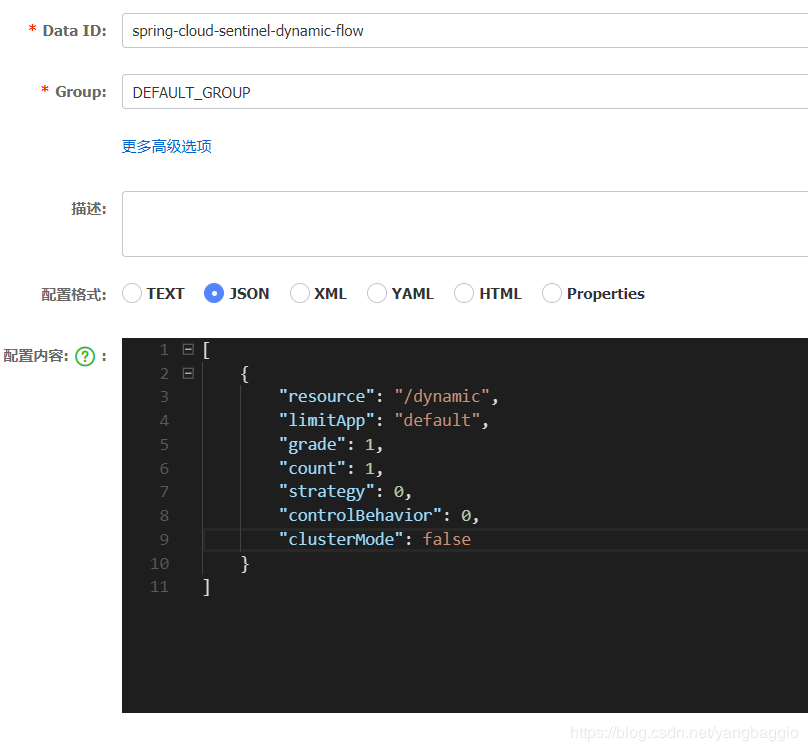Sentinel的理念是只需要开发者关注资源的定义,它默认会对资源进行流控。当然,我们还是需要对定义的资源设置流控规则,主要有两种方式:
- 通过FlowRuleManager.loadRules()手动加载流控规则。
- 在Sentinel Dashboard上针对资源动态创建流控规则。
针对第一种方式,如果接入Sentinel Dashboard,那么同样支持动态修改流控规则,但是基于Sentinel Dashboard所配置的流控规则,都是保存在内存中的,一旦应用重启,这些规则都会被清除。为了解决这个问题,Sentinel提供了动态数据源支持。
目前,Sentinel支持Consul、Zookeeper、Redis、Nacos、Apollo、etcd等数据源的扩展,接下来通过一个案例展示Spring Cloud Sentinel集成Nacos实现动态流控规则,步骤如下:
添加Nacos数据源的依赖包
<dependency>
<groupId>com.alibaba.csp</groupId>
<artifactId>sentinel-datasource-nacos</artifactId>
<version>1.7.0</version>
</dependency>
创建一个REST接口,用于测试
@RestController
public class DynamicController {
@GetMapping("/dynamic")
public String dynamic() {
return "Hello Dynamic Rules";
}
}
在application.yml文件中添加数据源配置
spring:
application:
name: sentinel-spring-cloud-demo
cloud:
sentinel:
transport:
dashboard: 192.168.56.1:7777
datasource:
- nacos:
server-addr: 192.168.56.1:8848
data-id: ${spring.application.name}-sentinel
group-id: DEFAULT_GROUP
data-type: json
rule-type: flow
部分配置说明如下:
- datasource: 目前支持redis、apollo、zk、file、nacos,选什么类型的数据源就配置相应的key即可。
- data-id:可以设置成${spring.application.name},方便区分不同应用的配置。
- rule-type:表示数据源中规则属于哪种类型,如flow、degrade、param-flow、gw-flow等。
- data-type:指配置项的内容格式,Spring Cloud Alibaba Sentinel提供了JSON和XML两种格式,如需要自定义,则可以将值配置为custom,并配置converter-class指向converter类。
登陆Nacos控制台,创建流控配置规则:
登陆Sentinel Dashboard,找到执行项目名称菜单下的“流控规则”,就可以看到在Nacos上所配置的流控规则已经被加载了。
当我们在Nacos的控制台上修改流控规则后,可以同步的在Sentinel Dashboard上看到流控规则的变化。
那么问题就来了,Nacos其实应该作为一个流控规则的持久化平台,正常的操作过程应该是在Sentinel Dashboard上修改流控规则,然后同步到Nacos上,但是遗憾的是,目前Sentinel Dashboard并不支持该功能。
所以,Nacos名义上是"Datasource",实际上充当的仍然是配置中心的角色,开发者可以在Nacos控制台上动态修改流控规则并实现规则同步。在实际开发中,很难避免在不清楚情况的情况下,部分开发者使用Sentinel Dashboard来管理流控规则,部分开发者通过Nacos来管理流控规则,这可能导致非常严重的问题。
要想使用Sentinel Dashboard来统一管理流控规则并同步到Nacos上,我们可以自己来实现。
Sentinel Dashboard集成Nacos实现规则同步
Sentinel Dashboard的流控规则下的所有操作,都会调用Sentinel-Dashboard源码中的FlowControllerV1类,这个类中包含流控规则本地化 的CRUD操作。
另外,在com.alibaba.csp.sentinel.dashboard.controller.v2包下存在一个FlowControllerV2类,这个类同样提供流控规则的CRUD,和V1版本不同的是,它可以实现指定数据源的规则拉取和发布。
@RestController
@RequestMapping(value = "/v2/flow")
public class FlowControllerV2 {
private final Logger logger = LoggerFactory.getLogger(FlowControllerV2.class);
@Autowired
private InMemoryRuleRepositoryAdapter<FlowRuleEntity> repository;
@Autowired
@Qualifier("flowRuleDefaultProvider")
private DynamicRuleProvider<List<FlowRuleEntity>> ruleProvider;
@Autowired
@Qualifier("flowRuleDefaultPublisher")
private DynamicRulePublisher<List<FlowRuleEntity>> rulePublisher;
FlowControllerV2依赖以下两个非常重要的类:
- DynamicRuleProvider: 动态规则的拉取,从指定数据源中获取流控规则后在Sentinel Dashboard中展示。
- DynamicRulePublisher: 动态规则的发布,将在Sentinel Dashboard中修改的规则同步到指定数据源中。
我们可以扩展这两个类,然后集成Nacos来实现Sentinel Dashboard规则的同步。
Sentinel Dashboard源码修改
修改Sentinel Dashboard的源码,具体实现步骤如下:
在GitHub中下载Sentinel Dashboard 1.7.1的源码。
使用IDEA工具打开sentinel-dashboard工程。
在pom.xml中把sentinel-datasource-nacos依赖的<scope>注释掉。
<!-- for Nacos rule publisher sample -->
<dependency>
<groupId>com.alibaba.csp</groupId>
<artifactId>sentinel-datasource-nacos</artifactId>
<!--<scope>test</scope>-->
</dependency>
修改resources/app/scripts/directives/sidebar/sidebar.html文件中下面这段代码,将dashboard.flowV1改成dashboard.flow,也就是去掉V1。修改之后,会调用FlowControllerV2中的接口。
<li ui-sref-active="active" ng-if="!entry.isGateway">
<!--<a ui-sref="dashboard.flowV1({app: entry.app})">-->
<a ui-sref="dashboard.flow({app: entry.app})">
<i class="glyphicon glyphicon-filter"></i> 流控规则</a>
</li>
在com.alibaba.csp.sentinel.dashboard.rule包中创建一个Nacos包,并创建一个类用来加载外部化配置。
@ConfigurationProperties(prefix = "sentinel.nacos")
public class NacosPropertiesConfiguration {
private String serverAddr;
private String dataId;
private String groupId = "DEFAULT_GROUP";
private String namespace;
}
创建一个Nacos配置类NacosConfiguration
@EnableConfigurationProperties(NacosPropertiesConfiguration.class)
@Configuration
public class NacosConfiguration {
@Bean
public Converter<List<FlowRuleEntity>, String> flowRuleEntityEncoder() {
return JSON::toJSONString;
}
@Bean
public Converter<String, List<FlowRuleEntity>> flowRuleEntityDecoder() {
return s -> JSON.parseArray(s, FlowRuleEntity.class);
}
@Bean
public ConfigService nacosConfigService(NacosPropertiesConfiguration nacosPropertiesConfiguration) throws NacosException {
Properties properties = new Properties();
properties.put(PropertyKeyConst.SERVER_ADDR, nacosPropertiesConfiguration.getServerAddr());
properties.put(PropertyKeyConst.NAMESPACE, nacosPropertiesConfiguration.getNamespace());
return ConfigFactory.createConfigService(properties);
}
}
创建一个常量类NacosConstants,分别表示默认的GROUPID和DATAID的后缀
public class NacosConstants {
public static final String DATA_ID_POSTFIX = "-sentinel-flow";
public static final String GROUP_ID = "DEFAULT_GROUP";
}
实现动态从Nacos配置中心获取流控规则
@Service
public class FlowRuleNacosProvider implements DynamicRuleProvider<List<FlowRuleEntity>> {
private static final Logger logger = LoggerFactory.getLogger(FlowRuleNacosProvider.class);
@Autowired
private NacosPropertiesConfiguration nacosPropertiesConfiguration;
@Autowired
private ConfigService configService;
@Autowired
private Converter<String, List<FlowRuleEntity>> converter;
@Override
public List<FlowRuleEntity> getRules(String appName) throws Exception {
String dataId = new StringBuilder(appName).append(NacosConstants.DATA_ID_POSTFIX).toString();
String rules = configService.getConfig(dataId, nacosPropertiesConfiguration.getGroupId(), 3000);
logger.info("pull flow rule from Nacos Config: {}", rules);
if (StringUtils.isEmpty(rules)) {
return new ArrayList<>();
}
return converter.convert(rules);
}
}
创建一个流控规则发布类,在Sentinel Dashboard上修改完配置后,需要调用该发布方法将数据持久化到Nacos中。
@Service
public class FlowRuleNacosPublisher implements DynamicRulePublisher<List<FlowRuleEntity>> {
@Autowired
private NacosPropertiesConfiguration nacosPropertiesConfiguration;
@Autowired
private ConfigService configService;
@Autowired
private Converter<List<FlowRuleEntity>, String> converter;
@Override
public void publish(String app, List<FlowRuleEntity> rules) throws Exception {
AssertUtil.notEmpty(app, "app cannot be empty");
if (rules == null) {
return;
}
String dataId = new StringBuilder(app).append(NacosConstants.DATA_ID_POSTFIX).toString();
configService.publishConfig(dataId, nacosPropertiesConfiguration.getGroupId(), converter.convert(rules));
}
}
修改FlowControllerV2类,将上面配置的两个类注入进来,表示规则的拉取和规则的发布统一用我们前面定义的两个实例,然后将FlowControllerV2这个类中的代码覆盖FlowControllerV1的代码
@RestController
@RequestMapping(value = "/v2/flow")
public class FlowControllerV2 {
private final Logger logger = LoggerFactory.getLogger(FlowControllerV2.class);
@Autowired
private InMemoryRuleRepositoryAdapter<FlowRuleEntity> repository;
@Autowired
@Qualifier("flowRuleNacosProvider")
private DynamicRuleProvider<List<FlowRuleEntity>> ruleProvider;
@Autowired
@Qualifier("flowRuleNacosPublisher")
private DynamicRulePublisher<List<FlowRuleEntity>> rulePublisher;
在application.properties文件中添加Nacos服务端的配置信息
sentinel.nacos.serverAddr=192.168.56.1:8848
sentinel.nacos.namespacec=
sentinel.nacos.group-id=DEFAULT_GROUP
使用下面命令将代码打包成一个 fat jar,然后启动。
Sentinel Dashboard规则数据同步
对于应用程序来说,需要改动的地方比较少,只需要注意配置文件中的data-id的命名要以-sentinel-flow结尾即可,因为在sentinel dashboard中我们写了一个固定的后缀。
spring:
application:
name: spring-cloud-sentinel-dynamic
cloud:
sentinel:
transport:
dashboard: 192.168.56.1:7777
datasource:
- nacos:
server-addr: 192.168.56.1:8848
data-id: ${spring.application.name}-sentinel-flow
group-id: DEFAULT_GROUP
data-type: json
rule-type: flow
登陆Sentinel Dashboard,进入“流控规则”,然后针对指定的资源创建流控规则。
进入Nacos控制台,就可以看到在Sentinel Dashboard中配置的流控规则。















评论 (2 条评论)